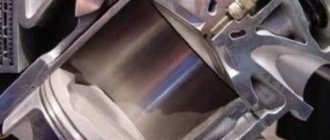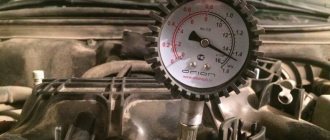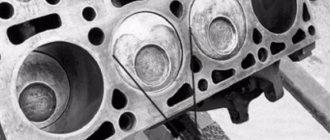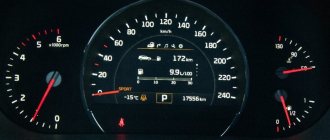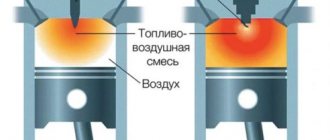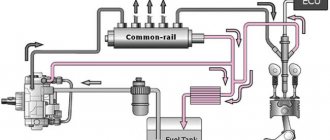It is known that the operating efficiency of an automobile internal combustion engine is directly dependent on the efficiency factor. Engine efficiency is expressed as the ratio of power transferred to the crankshaft and pistons. Modern internal combustion engines are more efficient than their outdated counterparts. For example, a 1.6 liter engine previously developed a power of no more than 70 horsepower, but now this parameter often reaches 150 hp. With.
Engine efficiency - what is it?
The efficiency of an internal combustion engine means the ratio of two quantities: the power supplied to the crankshaft during the operation of the engine and the power that is obtained by the piston through the pressure of the gases formed when the fuel is ignited.
Simply put, it is the conversion of thermal or thermal energy that is generated during the combustion of a fuel mixture (gasoline and air) into mechanical energy. The efficiency of the engine is influenced by the combination of various mechanical losses that occur at different stages of operation, as well as the movement of individual engine parts that cause friction. These parts cause the greatest losses, accounting for approximately 70% of their total. These parts include pistons, piston rings, and bearings. In addition, losses arise from the functioning of mechanisms such as magnetos, pumps, etc., which can reach up to 20%. The smallest part of the losses comes from resistance that occurs during the intake/exhaust process in the fuel system.
Summary
In the production of modern internal combustion engines, manufacturing plants invest heavily in the pursuit of increasing the efficiency of their products by at least a few percent. To this end, engineers are improving and complicating motor designs and using new materials to manufacture individual elements.
Sometimes it happens that the financial costs of developers are inappropriate, in comparison with the obtained result of 2 - 3%. Therefore, it may be more profitable to subject standard engines to various boosts, fine-tuning, and modifications using tuning improvements in small repair shops. As a result, the power and other traction characteristics of power units increase.
Coefficient of performance (COP) is a widely used characteristic of the efficiency of some system or device. In our case, this system is the internal combustion engine. It would seem, what kind of efficiency can we talk about in the world of modern engines? Isn’t it equal to 100 percent? But it turns out that just as there is no ideal black or white in our world, there is no car in which all the energy received from burning fuel is completely converted into mechanical energy, and the latter, in turn, into useful energy that presses the driver of the car into his seat.
Comparison of engine efficiency - gasoline and diesel
If you compare the efficiency of diesel and gasoline engines, the more efficient of them is, of course, diesel, the reason is as follows:
- A gasoline unit converts only 25% of energy into mechanical energy, while a diesel unit converts up to 40%.
- A diesel engine equipped with a turbocharger will reach 50-53% efficiency, and this is already significant.
So what is the efficiency of a diesel engine? Everything is very simple - despite the almost identical type of operation (both engines are internal combustion engines), diesel operates much more efficiently. Its fuel ignites according to a completely different principle, and it also has greater compression. Diesel heats up less, which means there are savings on cooling, and it also has fewer valves (significant savings on friction). In addition, such a unit does not have spark plugs or coils, which means there are no energy costs from the generator. The diesel engine operates at lower speeds (the crankshaft does not have to be cranked). All this makes him a champion in efficiency.
Formula for working in physics
For mechanical work, the formula is simple: A = F x S. If deciphered, it is equal to the applied force along the path along which this force acted. For example, we lift a load weighing 15 kg to a height of 2 meters. The mechanical work to overcome the force of gravity will be equal to F x S = mxgx S. That is, 15 x 9.8 x 2 = 294 J. If we are talking about the amount of heat, then A in this case is equal to the change in the amount of heat. For example, water was heated on the stove. Its internal energy has changed, it has increased by an amount equal to the product of the mass of water and the specific heat capacity by the number of degrees by which it has heated up.
Diesel engine efficiency – noticeable efficiency
The efficiency indicator for different engines differs and depends on several factors. Gasoline units have a relatively low efficiency, since they are characterized by a large amount of thermal and mechanical losses generated during the operation of a power plant of this type.
The second factor is friction resulting from the interaction of mating parts. Additional losses are caused by the operation of other systems, mechanisms and attachments, etc.
If we compare a diesel engine and a gasoline engine, the efficiency of a diesel engine is significantly higher than the efficiency of a gasoline unit. Gasoline engines have an efficiency within 25% of the amount of energy received. In other words, out of 10 liters of gasoline spent during the operation of the engine engine, only 3 liters are spent on performing work useful for the system. The rest of the energy generated from the combustion of gasoline was lost to various losses.
As for the efficiency of an atmospheric diesel unit, this figure is quite high and amounts to up to 40%. Installing a modern turbocharger allows this mark to be increased to an impressive 50%. Modern fuel injection systems installed on diesel internal combustion engines, together with a turbine, make it possible to achieve an efficiency of even 55%.
Such a significant difference in the performance of structurally similar diesel and gasoline internal combustion engines is due to a number of factors, including:
- Type of fuel.
- Method for forming a fuel-air mixture.
- Implementation of charge ignition.
Gasoline-powered units are more efficient than diesel ones, but have more significant losses, which are caused by energy consumption for heat. Accordingly, the useful energy of gasoline is less efficiently converted into full mechanical work, while at the same time a larger share is dissipated by the cooling system.
Video.
The efficiency of a diesel engine is the ratio of the power supplied to the crankshaft to the power received by the piston due to the pressure of the gases produced when the fuel used is ignited.
That is, this quantity is the energy that is converted from thermal or thermal energy into a mechanical quantity.
Gasoline engines have forced ignition of the air-fuel mixture with a spark plug.
Power and torque
When the displacement figures are the same, the power of a naturally aspirated petrol engine is higher, but is only achieved at higher speeds. The unit needs to be “twisted” more strongly, while losses increase, and fuel consumption increases accordingly. In addition, it is worth mentioning torque, under the influence of which the force that is transmitted from the engine to the wheels increases and contributes to the movement of the car. Gasoline engines reach their maximum torque level only at high speeds.
An atmospheric diesel engine with the same parameters reaches peak torque only at low speeds. This contributes to less fuel consumption required to perform work, resulting in higher efficiency and more economical fuel consumption.
Compared to gasoline, diesel fuel generates more heat, since the combustion temperature of diesel fuel is much higher, which contributes to higher detonation resistance. It turns out that a diesel engine has much more useful work done on a specific amount of fuel.
This is interesting
Science has proven that the efficiency of any mechanism is always less than one. This is due to the second law of thermodynamics.
For comparison, the efficiencies of various devices:
- hydroelectric power stations 93-95%;
- NPP – no more than 35%;
- thermal power plants – 25-40%;
- gasoline engine - about 20%;
- diesel engine - about 40%;
- electric kettle – more than 95%;
- electric vehicle – 88-95%.
Science and engineering do not stand still. Ways are constantly being invented to reduce heat loss, reduce friction between parts of the unit, and increase the energy efficiency of equipment.
Energy value of diesel fuel and gasoline
Diesel oil contains more heavy hydrocarbons than gasoline. The lower efficiency of such an engine compared to a diesel unit is due to the energy component of gasoline and the method of its combustion. When equal amounts of gasoline and diesel fuel are burned, a greater amount of heat is characteristic of gasoline. Heat in a diesel unit is more fully converted into mechanical energy. Accordingly, when burning an equal amount of fuel in a certain amount of time, it is the diesel engine that will do more work.
In addition, it is necessary to take into account the characteristics of injection and conditions conducive to high-quality combustion of the mixture. In a diesel unit, fuel enters separately from the air and is injected directly into the cylinder at the end of compression, bypassing the intake manifold. The result of this process is a temperature higher than that of a gasoline engine and maximum combustion of the fuel-air mixture.
Types of power systems
The carburetor option involves mixing air and gasoline in the inlet pipe of the carburetor. Recently, the production of such engine options has been significantly reduced due to the insignificant efficiency of such engines and their inconsistency with modern environmental standards.
In injection engine versions, fuel is supplied using one injector (nozzle) into the central pipeline.
In the case of distributor injection, fuel enters the engine through several injectors. In this case, the maximum power increases, which significantly increases the efficiency of the diesel engine.
At the same time, gasoline consumption and toxicity of processed gases are reduced due to a fixed fuel dosage by electronic control systems of the automobile engine.
When discussing the efficiency of a modern diesel engine, you need to know about the injection system of the gasoline mixture into the storage chamber. If fuel is supplied in portions, this guarantees that the engine runs on lean mixtures, which helps reduce fuel consumption and reduce the emission of harmful gases into the atmosphere.
More about losses
If we compare gasoline and diesel and internal combustion engines, we can say that the efficiency of a gasoline engine is at a lower level - within 20-25%. This is due to a number of reasons. If, for example, you take the fuel entering the internal combustion engine and “convert” it into percentages, you will get, as it were, “100% of the energy” that is transferred to the motor, and then, the loss of efficiency:
- Fuel efficiency. Not all of the fuel consumed is burned; most of it leaves with exhaust gases. Losses at this level amount to up to 25% efficiency. Today, of course, fuel systems have improved, an injector has appeared, but this does not solve the problem 100%.
- The second is heat loss. Some of the heat leaves the internal combustion engine with exhaust gases; in addition, the engine warms itself and a number of other elements: its body, the fluid in the internal combustion engine, the radiator. All this accounts for another 35%.
- The third thing that efficiency is spent on is mechanical losses. These include components of the power unit where there is friction: connecting rods, rings, all kinds of pistons, etc. This also includes losses caused by the load from the generator, for example, the more electricity it generates, the more it slows down the rotation of the crankshaft. Of course, various lubricants for internal combustion engines play their role, but still they do not completely solve the problem of friction, and this is an additional loss of up to 20% efficiency.
Thus, the remaining efficiency is no more than 20%. Today there are gasoline options in which the efficiency indicator is slightly increased - up to 25%, but, unfortunately, there are not many of them. For example, if a car consumes 10 liters of fuel per 100 km, then only 2 liters will be spent on engine operation, and the rest are losses.
Of course, there is an option to increase power by boring the head, but it is used quite rarely, since this introduces certain changes to the design of the internal combustion engine.
Designers are constantly striving to increase the efficiency of both gasoline and diesel units. Increasing the number of exhaust/intake valves, fuel injection control (electronic), throttle valve, active use of variable valve timing systems and other effective solutions can significantly increase efficiency. Of course, this applies to a greater extent to diesel units.
With the help of such improvements, a modern diesel engine is able to almost completely burn diesel fuel in the cylinder, producing maximum torque. It is low speeds that mean insignificant losses during friction and the resulting resistance. For this reason, the diesel engine is one of the most productive and economical engines, the efficiency of which quite often exceeds 50%.
Thermal Cycle Analysis
The thermal cycle includes four thermodynamic basic processes. First, the state of the working fluid is transformed, and then it returns to its original state: compression, heat generation, expansion and heat removal.
Each of these processes is carried out according to the following scheme, which determines the conditions for the implementation of the cycle:
- Isothermal - work is performed at a constant temperature.
- Isobaric - the operating cycle is implemented at constant pressure.
- Isometric - the thermal process occurs at a constant volume
- Adiabatic - the cycle is carried out at constant entropy.
In order for the process to be as close to reversible as possible, there are two ways to move the piston: isothermal - this means that heat gradually enters or leaves the reservoir at a temperature infinitely different from the temperature of the gas in the piston, and adiabatic, in which no heat exchange occurs at all, the gas acts like a spring.
Thus, when heat is added and the gas expands, the temperature of the gas must remain the same as that of the heat source, with the gas expanding isothermally. Likewise, it will later be compressed in the cycle isothermally, releasing heat.
To find out efficiency, you need to follow the engine through its entire cycle, find out how long it runs, how much heat is taken from the fuel, and how much energy is lost in preparation for the next cycle.
The thermal cycle characteristics associated with a heat engine are typically described using two state diagrams : a PV diagram showing the pressure-volume relationship and a TS diagram showing the temperature-entropy pair.
For a constant mass of gas, the operation of a heat engine is a repeating cycle, and its PV diagram will look like a closed figure.
Literature
- [1] Kotelnikov V., Medved A. Aviation diesel engines, or the thorny path A.D. Charomsky // Engine.-2002, No. 2(20).
- [2] Zubov E. Legendary V-2: three pages of fate // Engine. 1999, No. 4(4).
- [3] Ways to resolve the issue of domestic tractor construction // Bulletin of the Scientific Automotive Institute. - 1922, No. 4.
- [4] Bukharin N.A. Modern tractors. Design and operation. -M-L., 1931.
source: Alexander Kirindas, Mikhail Pavlov “MECHANICAL TRACTION. DIESEL Efficiency" // "Equipment and weapons" January 2012
ESTEC Basic Components
Gasoline engine Gazelle Next 2.7 l. timing device, technical specifications Evotech 2.7
The main design features of the ESTEC are the Atkinson cycle, a geometric compression ratio of 13.5:1 and a liquid-cooled EGR system (the regular 1NR-FE has an 11.5:1 compression ratio and internal exhaust gas recirculation). The electrically driven VVT-iE continuously variable phase control system is a key element in the implementation of the Atkinson cycle. It allows you to quickly and accurately adjust the lift of the intake valves and avoid difficulties arising from the difference in temperature and oil pressure during a cold start and on a warm engine.
The exhaust gas recirculation system uses an efficient cooler and a fast-acting valve. In addition, the inlet pipe, cooler and valve are directly connected to each other to reduce the formation of condensation from the cooler.
The optimized shape of the intake ports ensures rapid filling of the cylinders, and the created swirl contributes to improved combustion of the mixture. To meet both performance and fuel consumption requirements, the exhaust manifold is designed in a 4-2-1 design. This allows you to reduce the amount of residual gases in the engine cylinders.
Restoring Performance
Increasing the compression ratio to 13.5:1 reduced torque from 104 Nm to 96 Nm. To make up for this loss, Toyota has used a reshaped exhaust manifold that reduces residual gases and cylinder temperatures; a new water jacket that maintains optimal cylinder surface temperature; optimization of injection time. The combination of these measures (of which the modified exhaust manifold plays a major role) has increased torque to 105 Nm.
At light loads, excessive torque fluctuations occur due to the operation of the cooled EGR. To eliminate this drawback, an exhaust valve control system (Exhaust VVT) and internal exhaust gas recirculation are used. At medium and high loads, the Exhaust VVT is suspended and the EGR valve pitch is increased.
Cooling is an effective measure against torque reduction in engines with high compression ratios. However, at the same time this leads to increased fuel consumption due to increased friction and cooling losses. In conventional engines, the top of the cylinder heats up more than the bottom. Due to uneven heating, friction in the cylinder increases. In ESTEC, a new water jacket with a special gasket equalizes the temperature in different parts of the cylinder surface, reducing friction losses and the possibility of detonation.
Atkinson cycle
Atkinson cycle
In an Atkinson cycle engine, during the intake stroke the intake valve closes not near BDC, but much later. This provides a number of benefits.
Firstly, pumping losses are reduced, because part of the mixture, when the piston has passed BDC and began to move upward, is pushed back into the intake manifold (and then used in another cylinder), which reduces the vacuum in it. The combustible mixture pushed out of the cylinder also takes away some of the heat from its walls.
Since the duration of the compression stroke in relation to the power stroke decreases, the engine operates according to the so-called cycle with an increased expansion ratio, in which the energy of the exhaust gases is used for a longer time, i.e., with a decrease in exhaust losses. Thus, we get better environmental performance, efficiency and greater efficiency, but less power.
Definition option
In the technical documentation you can find information about the power of the internal combustion engine. After filling it with fuel and operating at maximum speed for several minutes, the remaining fuel is drained. By subtracting the final result from the initial volume and armed with density, you can calculate the mass of the fuel mixture.
Currently, the electric power unit has maximum efficiency. Its efficiency can reach 95%, which is an excellent result. If the first engines with an engine capacity of 1.6 liters developed no more than 70 horsepower, today this figure reaches 150 horsepower.
Efficiency is the ratio of the power supplied to the engine crankshaft to the value obtained from the combustion of the gas mixture by the piston. Depending on what fuel is used to run a car engine, efficiency can range from 20 to 85 percent. Of course, manufacturers of fuel systems are looking for ways to improve them, allowing them to significantly increase the final value of the internal combustion engine.
To reduce mechanical losses from the generator load and friction, lubricants are currently used in industry. But, despite such achievements, no one has yet managed to completely cope with the force of friction.
Even after improvements to the gasoline engine, it was possible to achieve a change in its efficiency up to 20 percent; only in some cases it is possible to increase the efficiency to 25%.
A higher efficiency rating indicates fuel efficiency. For example, with a diesel engine capacity of 1.6 liters in the urban cycle, fuel consumption is no more than 5 liters. For a gasoline analogue, this value reaches 12 liters. The diesel unit itself is much lighter and more compact, and is also considered a more environmentally friendly option than a gasoline engine.
These positive technical characteristics guarantee diesel engines a longer operational life.
